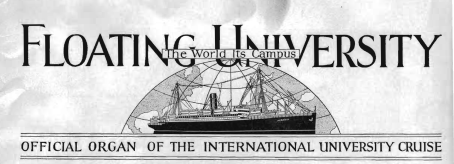
In September 1926, 500 American university students left New York aboard the Floating University, on a journey around the world that involved stops at forty-seven ports and visits to foreign dignitaries including the King of Siam, the Sultan of Lahej, Mussolini and the Pope. Organised by New York University professor, James Edwin Lough, and promising a ‘world education’ to its students, the venture was influenced by new approaches to psychology and education, the internationalism of the period, as well as economic and social imperatives. But if its organisers thought the voyage would be a way for American students to know the world, it also became a laboratory for American imperial diplomacy, a stage for nationalist and anti-imperial politics, and a magnet for scandal.
For the last few years I’ve been chasing the Floating University and its 500 students in archives scattered across the United States and the world. I’ve found them in diaries and artwork and photographs and radio transcripts and legal records and newspaper articles. Much like the students on the ship, I’ve frequently found myself in unfamiliar surroundings, following leads down dark passageways and IT’S ALL SO INTERESTING. I mean who wouldn’t be diverted by the thrills and spills of what has often seemed the Great Gatsby version of a gap year?!
But more recently I’ve been trying to work out what the whole thing adds up to. There are so many possible angles of approach and there’s so many threads to the story that the project has sometimes seemed to me to be in danger of proliferating endlessly. But for better of worse, I’ve got to begin. For the next few months, thanks to New College and the Rothermere American Institute, I have a desk in Oxford and my job is to put words on a page.
Which is obviously why I’m getting straight on with that task by writing this blog.


I was spring 1974 would like to contact you my phone 213 215 0145 I live in ridgecrest calif…